Average sizes and life expectancy for this breed:
The Russian Blue is the cat world's aristocrat because of their shimmering coats and exquisite, delicate looks. They have beautiful emerald green eyes that complement their coat colour. Russian Blues have very loving smiles on their adorable faces, making these medium-size cats one of the most popular and endeared breeds throughout the world.
This cat breed can draw instant attraction with their silvery blue, glittering coat and enchanting green eyes. However, it is their intelligent, playful and comical nature that makes a Russian Blue the perfect pet for a lot of families.
Russian Blue cats are sweet-natured, loyal, and affectionate. They are known to be social, intelligent, and friendly to people. You can see them following their owner from room to room, sometimes even on their shoulder.
While they are commonly docile, Russian Blue cats can be very vocal and use their voice to chat back and forth and communicate with others. They will always respond to you when you speak to them.
They are very observant and persistent. Once a Russian Blue cat thinks you are worthy of his or her attention, he tends to become extraordinarily loving and expects the same in return. They get along well with children and other pets, making them an excellent companion.
This cat breed thrives on structure, and thus, it is a challenge for them to adapt to changes – including unknown visitors and different meal times to what they are used to. However, Russian Blue cats are well-suited for apartment living as they can be left home alone without any unfortunate incidents. They enjoy alone time and usually look for a quiet and private space to sleep. Thus, they make ideal companions for those who spend long hours at work.
See available kittens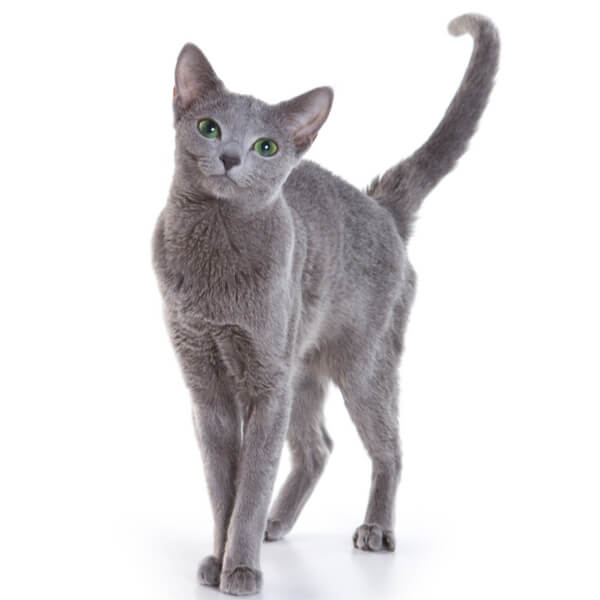




Some people believe that Russian Blue cats are initially from northern Russia, specifically the Archangel Isles. According to the Cat Fanciers' Association (CFA), there is a rumour that the Russian Blue cat breed comes from the cats kept by the Russian Czars empire. It is no surprise that such a stately cat has such royal roots, with its sleek, sophisticated behaviour.
It is also believed that they arrived in Great Britain and Northern Europe in the 1860s from travelling with sailors from Russia.In 1875, the Russian Blue cat made its first public appearance as an exhibit at London's Crystal Palace as the "Archangel Cat."
While it was exhibited alongside other blue cats, by 1912, the Russian Blue was given its own classification after its introduction to the United States in the early 1900s. However, the cat breed took the attention and affection of pet lovers' hearts after World War II, and it has been gaining popularity increasingly since the 1960s.
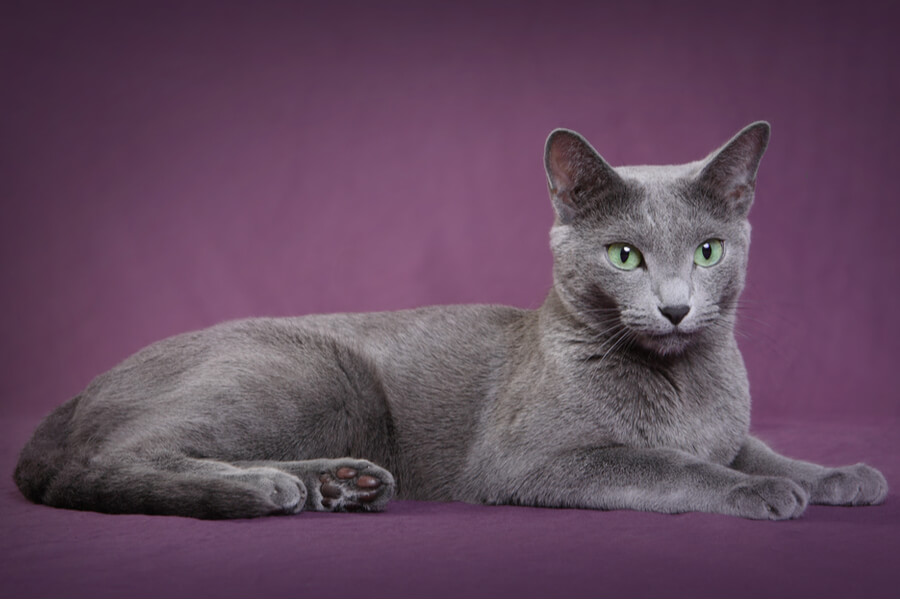

Russian Blue cats look larger than they are because of their highly dense, soft double coat. They may be the right choice for pet parents with allergies because they do not shed much and generate lower levels of the glycoprotein Fel d 1, a known allergen, than other cat breeds.
The Russian Blue have a dense, short and very luxurious coat which is their trademark. Their double coat has a dense, very soft undercoat that stands away from their body. The most common coat colour is a charcoal grey shade tipped with light, shimmering silver. However, they can also come in white or black
Russian Blues are agile, athletic, and well-balanced cats that move very gracefully. They are exquisite, medium to large-sized cats with muscular, agile bodies and graceful, long, finely boned legs. Males are generally heavier and larger than their female counterparts.
Their heads are wedge-shaped, and they always look like they are wearing a smile on their faces which is another of the cat breed's distinguishing and attractive physical traits. They have wide cheekbones and are set nice and high.
Their large almond-shaped eyes are emerald green, but they are not born with green eyes. Like all kittens, Russian blues are born with blue eyes. This fades to a light or golden yellow colour, which gains a green ring when they are around four months old. Their eyes do not reach the fully bright green shade until they reach adulthood.
The top of their head looks flat between their ears, and muzzles are wide with well-defined and prominent whisker pads. Their large ears are flared, wider at the base, so they frame their face adding to their foreign looks. Their forehead looks level with the upper part of their eye, creating a unique angle. Their chins are well in line with the tip of their nose. Their tails are moderately long and well in proportion to their body.
The Russian Blues are sweet-tempered, loyal cats who will follow their owners everywhere. So, do not be surprised if this gorgeous feline greets you at the front door. They are also known to be very affectionate without being demanding. That's why this cat breed has become a popular feline companion for older adults. Moreover, they are also recognized to be patient by nature, making them good around children. They will wriggle their way out of a kid's grip rather than use their claws to get away.
While Russian Blues have a tendency to attach to one pet parent, they will still show affection to their whole family and somewhat demand it in return. Russian Blues are very social creatures, but they also enjoy having some alone time. They will eagerly look for a quiet, private place to sleep.
While this cat loves company, they can amuse themselves during the day while their human companion is at work. They do not mind if you are away for extended periods or at work all day. Keep in mind that they do need a lot of playtime and quality time with humans when you are home though.
Unlike other energetic, intelligent cat breeds, Russia Blues are not destructive but tend to move around the house like a graceful Russian ballerina. When their human companion is at home, their refined sense of humour and cleverness will never fail to amuse you.
They tend to be a little shy around people they do not already know. They prefer to observe them first from a distance which makes people think Russian Blues are distant and reserved. But, once they decide a person is worthy of their attention, they will go right up to them to say "hello". Still, Russian Blues may hide during large parties.
Russian Blues adore being petted and given as much love and attention as they can get when their human companion is around. With this said, they are not clingy or needy by nature and are quite happy and content to be left on their own as long as it is not for a long period of time.
Russian Blues can be very talkative but are usually soft-spoken. They will talk in quiet meows to let their owner know they need food, water, or attention. This cat breed is super bright, independent, energetic, and spirited. Russian Blues are also excellent hunters who enjoy playing. However, as they age, they tend to get calmer.

.jpg)
Russian Blues are highly intelligent pets and need physical and mental stimulation. That’s why it is essential to give them access to a wide range of toys. Russian Blues enjoy playing interactive games with their owners. They also have a strong hunting instinct, so a feathered fishing pole toy is the perfect plaything. In addition, they are fond of jumping, retrieving, and climbing to high places where they can perch and observe people and situations.
Russian Blues are very smart and observant and can learn things like how to open drawers and doors and play fetch. Challenge their bright minds and keep them focused by teaching them commands, games and tricks. Give them many puzzle toys and other interactive toys that will reward them with kibbles or treats when they learn how to operate them.
When a Russian Blue is properly socialised and trained during their kittenhood, they will thrive as a well-rounded and well-mannered feline companion.
Russian Blues have short, close-lying, thick, dense coats. This means that they are low maintenance in the grooming department. Weekly brushing and wiping over with a chamois leather is all it takes to keep their coats healthy and in good condition with a good sheen on them. Like other cats, they tend to shed their hair the most in the Spring and then again in the Autumn. This is when more frequent brushing or combing is needed to keep it in tip-top condition.
Cats must get used to combs and brushes from an early age to avoid matted fur from the offset. There's a wide variety of cat combs and brushes available, depending on what works for your cat. Start with a very soft brush that does not pull at fine kitten fur or damage their skin. Each time you finish brushing, give a small treat. If regular coat care does not cause any issues, try more effective combs and brushes when they reach adult age.
For their dental hygiene, aim to brush their teeth at least weekly, but more often if possible as this will help to prevent periodontal disease. Trim their nails twice a month or when needed. For their almond-shaped eyes, wipe the corners with a soft, damp cloth to eliminate any eye discharge. Make sure to use a separate part of the cloth for each eye to avoid spreading any infection.
Check the ears weekly. If their ears look dirty, wipe them out with a cotton ball or soft damp cloth moistened with a vet-approved ear cleaner. If the ear has a foul odour, it is best to contact your vet for treatment.
Their litter boxes should always be clean as they are precise about bathroom hygiene. If it is left unclean, they tend to use other places in the house.


The Russian Blue's average life expectancy is between 15 and 20 years when correctly cared for and given an appropriate, excellent, high-quality diet to suit their age. Fortunately, the Russian Blue is well-known to be one of the healthiest cat breeds. Unlike many other pedigree cats, it is not commonly known to suffer from any hereditary or genetic health problems.
Even so, we always highly recommend that you only buy from a registered and reputable breeder who runs DNA health checks on all their cats. That way, you can rest assured that your Russian Blue will enjoy a long and happy life with you.
Also note that Russian Blue cats are well-known for their healthy appetite. It is vital to ensure that they do not overeat by keeping them on a consistent feeding schedule and not giving them too many cat treats.
Russian Blues are an excellent choice for families with children because of their easy-going, laid-back, loving personalities. However, an adult should always supervise any interaction to make sure everything stays calm and in order.
This cat breed also gets on well with other cats, dogs and other smaller animals, particularly if they were appropriately socialised at an early age and have grown up together in the same household. They are incredibly friendly and sociable by nature. Still, it’s always best to oversee any interaction between a Russian Blue cat and smaller pets.
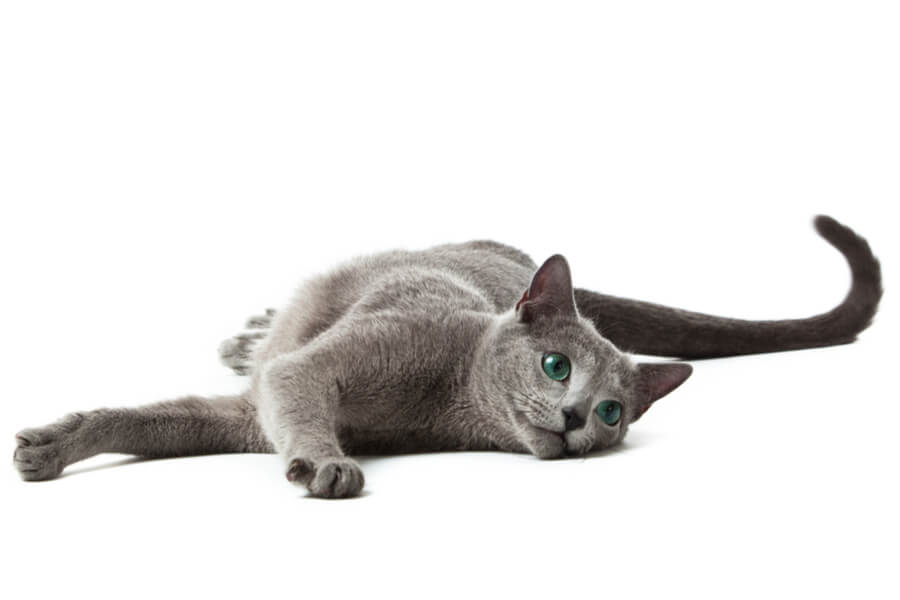

We can connect you with Breeders that are specialized in this particular breed.
See available kittens
07-05-2024
Breed: Russian Blue
Location: Poland
Breeder: Abyssinian and Russian Blue #355
Gender: Female
Ready To Go Home: I'M READY TODAY!

07-05-2024
Breed: Russian Blue
Location: Poland
Breeder: Abyssinian and Russian Blue #355
Gender: Male
Ready To Go Home: I'M READY TODAY!

Ethiopia
Size : Medium
Coat : Short
Registration : GCCF, TICA, CFA, FIFe
Vocality : Low
Hypoallergenic : No
Grooming : Once a Week

Thailand
Size : Medium
Coat : Short
Registration : GCCF, TICA, CFA, FIFe
Vocality : Low
Hypoallergenic : No
Grooming : Once a Week

France
Size : Medium
Coat : Short
Registration : GCCF, TICA, CFA, FIFe
Vocality : Low
Hypoallergenic : No
Grooming : Once a Week

United States of America
Size : Medium
Coat : Long
Registration : GCCF, TICA
Vocality : Low
Hypoallergenic : No
Grooming : Twice a Week


Need some advice?
Whether you're a first time pet owner, an experienced pet owner, a new or long-time breeder, or just curious about pets, we've got you covered!
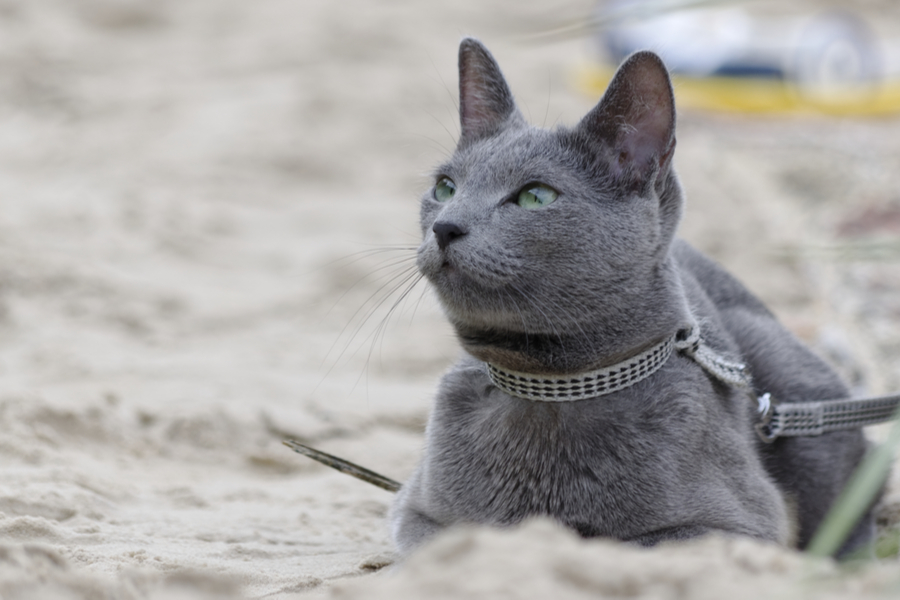
January 17, 2024
What Is The Personality Of Russian Blue Cats?
Russian Blue cats are most known for their distinctive shimmery blue-silver coat and piercing green eyes. However, this breed’s calm and gentle temperament is what makes them shine the most in the feline world.
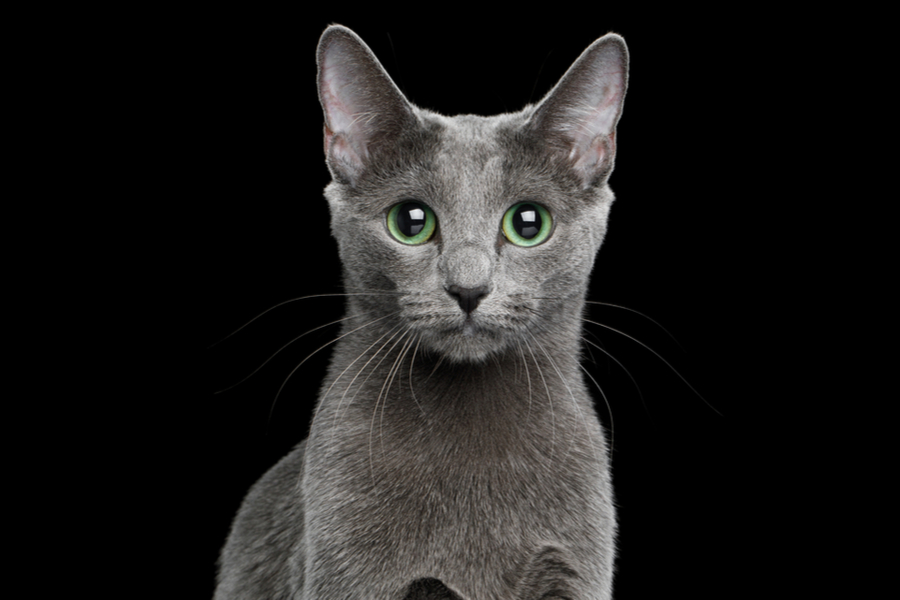
January 17, 2024
10 Facts About Russian Blue Cat Breed
Russian Blues are one of the most aesthetically stunning cat breeds, with a gorgeous plush silvery coat and vibrant green eyes. However, it’s not only their appearance that is beautiful; their nature is too.
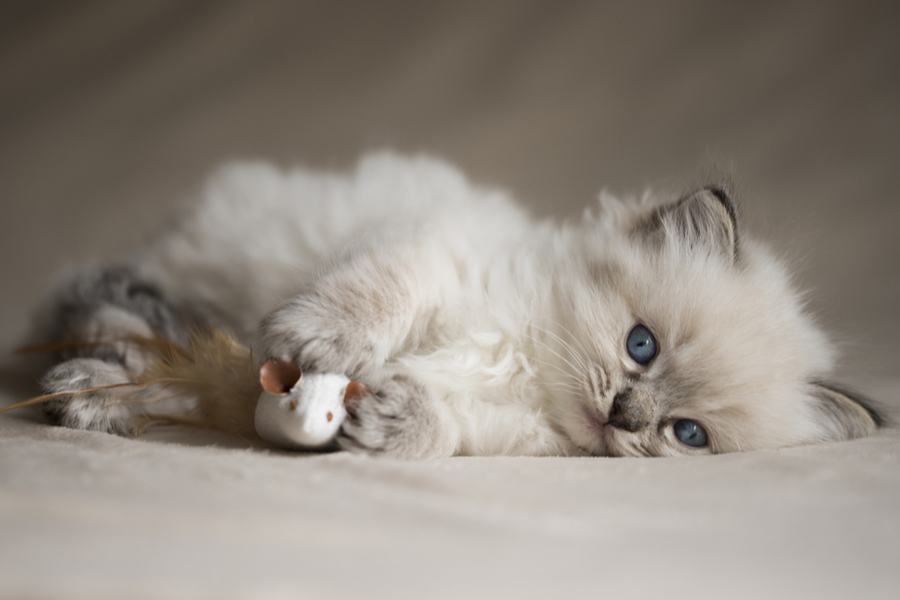
January 17, 2024
How To Choose The Right Cat Breed for You
Cats can make the most fantastic animal companions; they are adorable, friendly, and loving. However, not all felines are created equal. There are many different breeds, of which each has its unique personality traits.
Need some help?
Contact us to speak to our friendly advisor, who will gladly help you find your dream pet!



We are registered in England and Wales under registration number 12568840,
and our registered office is at 58-60 Kensington Church Street, W8 4DB London, England.
© 2023 The Pedigree Paws